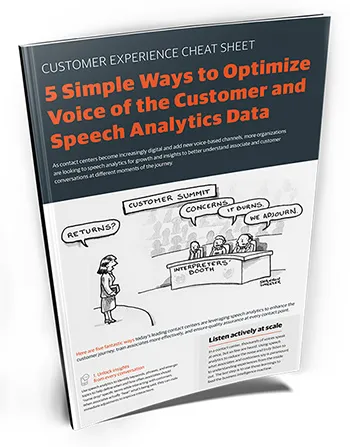According to Forrester’s CX index, 73 percent of companies say improving customer experience (CX) is a priority, but only 1 percent actually deliver an excellent experience. Improvement begins with understanding where to focus your investment dollars. That requires a consistent approach to CX measurement, across all channels, that will enable you to identify which interactions have the biggest impact (positive or negative), and allocate resources where they will have the most impact.
Today, most companies only look at parts of the customer experience. They focus on channels in a siloed fashion, with each stakeholder measuring their channel experience in isolation, focusing on channel-specific metrics over a specific time period. An eConsultancy report found that 30 percent of leaders implement customer experience initiatives on a channel-by-channel basis, and 41 percent say each department sets its own customer experience agenda.
Typical customer experience metrics only tell you part of the story
Take the contact center, for example. In CX survey questions regarding their experience, data is typically gathered relating to customer satisfaction, associate courtesy and respect, associate knowledge about products and services, clear communication, first call resolution, and speed to answer.
While these are perfectly reasonable metrics, there are two drawbacks to this approach. First, the metrics are not extensible to other channels (outside of customer satisfaction) for integrated CX channel benchmarking. And second, with the exception of customer satisfaction, they ask customers questions that can be derived from call monitoring QA efforts/call disposition records. This breaks a CX golden rule: Don’t burden customers with questions for which you already know (or should know) the answer.
This approach to CX measurement isn’t sustainable, especially as companies focus their efforts on creating omnichannel, seamless experiences. Customer interactions occur across channels, and they need to be measured in a more consistent way to understand the true impact of activities.
These four CX questions uncover a more complete customer picture
We have identified four simple questions at the heart of CX measurement that are helping our clients integrate their efforts across channels:
Customer Satisfaction: How would you rate your overall experience with X?
This metric focuses on the individual event/action/support associate, and should be measured on a scale ranging from poor to excellent. In this question, X could be a call center associate, app, website, event, or other interaction source.
Frictionless Interaction Score: To what degree do you agree with the statement: (BRAND) made it easy for me to X?
This metric focuses on your company’s process—how easy it was for the customer to achieve what he or she intended through the channel in question, measured on a scale ranging from disagree to agree. This is our adaptation of what is sometimes referred to as a Customer Effort Score.
Brand Sentiment Score: How has your opinion of (BRAND) changed as a result of your interaction with X?
This question gets at the heart of whether an experience has materially changed the customer’s perception of your brand, and should be measured on a scale from negative to positive. In this question, X could be a call center associate, app, website, event, or other interaction source.
Net Promoter Score: How likely is it that you would recommend (BRAND) to a friend or colleague?
Net Promoter methodology requires a 0-10 point scale from which your Net Promoter Score can be calculated by subtracting the percentage of customers who are detractors (0-6) from the percentage of customers who are promoters (7-10). We recommend benchmarking NPS after a customer’s initial purchase to gauge the impact of each interaction.
In addition to the above customer survey metrics, developing a Brand Engagement Index—which measures how your customers’ engagement with your brand changes over time—can be correlated to different experiences. It is incredibly useful at both the individual and aggregate levels. When building a Brand Engagement Index, include as many inputs as possible, from customer purchases, support channel usage, visits, email engagement, and more.
Taken together, these four questions provide a more complete view of a given experience—from the individual channel or employee to the overall brand process and the impact of the experience on both brand perception and advocacy. Analyzing results within and across channels provides insight into the overall customer experience, allowing companies to prioritize actions for greatest impact.
Turning CX insights into action
By correlating each metric to one another and to key business objectives (e.g., sales, loyalty, etc.), it’s possible to identify which interactions have the greatest impact (positive or negative). From there, you can prioritize the deployment of resources based on their upside potential. For example, you may find that for your industry and customer base, the Frictionless Interaction Score is more predictive of loyalty than the other three metrics, allowing you to prioritize investments on processes and training to make it easier for your customers to engage in that aspect of the customer experience. In the contact center, for example, this might mean adding online chat, making improvements to your knowledge base, revamping your IVR, or improving handoffs to live customer support across channels.
We also recommend conducting unstructured data analysis of customer verbatims, as well as call and chat logs. These both validate results and gain a broader picture than just those customers who choose to respond to your survey questions.
Companies that can get to this level of analysis will be at an important advantage. Most companies are not sophisticated enough to put it into practice currently. Dimension Data’s 2017 Contact Center Benchmark report states that 63 percent of contact center leaders report that their systems are not integrated. Another 58 percent say their channels operate in silos, and 43 percent report inconsistent data across channels.
Things to consider when measuring customer loyalty and overall satisfaction
When implementing your new customer survey metrics, be sure to define scale, frequency, and exclusions. Putting thought into these metrics ensures you have actionable, consistent data to analyze for a given channel, and to compare across channels.
In addition, it can be difficult for companies to limit the survey to these four questions. This is typically the result of channel owners being vested in the current metrics and worried about losing the insight they provide. To overcome this resistance, we recommend considering a phased approach. Begin with the four recommended survey questions, and issue follow-ups as needed. For example, if customer satisfaction is low and verbatims do not shed light as to the reason, issue a follow-up survey to understand the key drivers. In the contact center, for example, this might include some of the traditional metrics like associate knowledge, courtesy, and respect.
Customer input is a valuable tool in helping identify opportunities to transform the customer experience in a way that creates more positive experiences and more loyal customers. The first step is asking the right questions, consistently, across all channels for integrated CX optimization.
More CX metrics resources to explore
We hope you enjoyed this article exploring key aspects of CX performance metrics. Here are some additional resources from our customer experience experts.

Voice of the Customer Best Practices and Strategy: When gathering cx metrics in contact centers, many organizations say they have active voice of the customer (VOC) programs in place. They ask customers to complete CX survey questions to measure performance and they often also use speech analytics to gain additional customer experience metrics and insights. But despite utilizing these sophisticated tools, too often they are not really listening. A voice of the customer strategy is an essential part of a strong CX analytics platform, but is often misunderstood and therefore poorly implemented. In this article, we dispel four common myths about voice of the customer and show how to incorporate digital and mobile VOC best practices to gain valuable customer insights.
Unlock Customer Insights Hidden in Plain Sight: Customers have multiple contact options today beyond just voice calls. IVR, online self-service, virtual assistants, live chat, online forums, mobile apps, social media, and more. Chances are, you’re not optimizing the customer insights living in your contact center and beyond, across all of these touchpoints. In this strategy guide, we explain how businesses can combine existing data from multiple sources and start applying customer insights to deliver personalized and engaging customer experiences and operational objectives.
Customer Churn Prevention Best Practices: Retaining customers helps decrease costs, increase profitability, and improve customer lifetime value (CLV). In this article we look at three strategies to improve customer retention rate and customer churn rate.
5 Simple Ways to Optimize Voice of the Customer and Speech Analytics Data: In this guide, learn 5 ways to use speech analytics to augment employee experience on the floor and customer experience over the phone. Today’s leading contact centers leverage speech analytics technology to enhance customer relationships, train associates more effectively, and ensure quality assurance (QA) across all channels and at every contact point.
Call center customer analytics blind spots and how to avoid them: Customer analytics that include many different data sources enable businesses to understand not just what happened, but also, who, why, and what next? By combining customer sentiment and voice of the customer data over the full customer lifetime with marketing, product, and sales data, companies have a better understanding of who their customers are, why they’re contacting the brand, and much more, which can all improve customer retention and lifetime value.
How to Extract the Top 3 Contact Center CX Metrics that Matter: Measuring customer satisfaction is crucial to knowing when and how your customers’ attitudes change toward your brand – so you can pivot quickly, respond better, mitigate pain points, and continue to deliver excellent CX to improve customer loyalty.
Six Ways Analytics Impact Business Outcomes: Top performing companies always have a clear view of the customer journey so that major customer experience measurement metrics, such as quality score, CSAT average handle time, and resolution time, are optimized. But how do you consistently create satisfied customers who will be likely to recommend your company to others? In this article we explain how to leverage the power of predictive analytics to optimize KPIs and drive results.
Hit the average handle time sweet spot: When looking at CX performance metrics, one obvious metric to analyze is average handle time (AHT). It’s one of the most common CX metrics. AHT targets run the gamut from seconds to hours, depending on the call type, customer value, or complexity of the issue. Most simple transactions fall within the range of a few minutes. But where do average handle time and average resolution time actually come from? In this article we explore the efficiency calculators that create average handle time, as well as provide best practices on how to hit the AHT sweet spot.
Omnichannel Data is the key to CX Success: Omnichannel data mapping that shows the total number of customer interactions across the entire customer journey can help uncover important digital customer experience metrics for channel optimization. In this article, we talk about giving your omnichannel strategy a data twist, and show the importance of utilizing customer feedback and customer data to help optimize your omnichannel approach.















